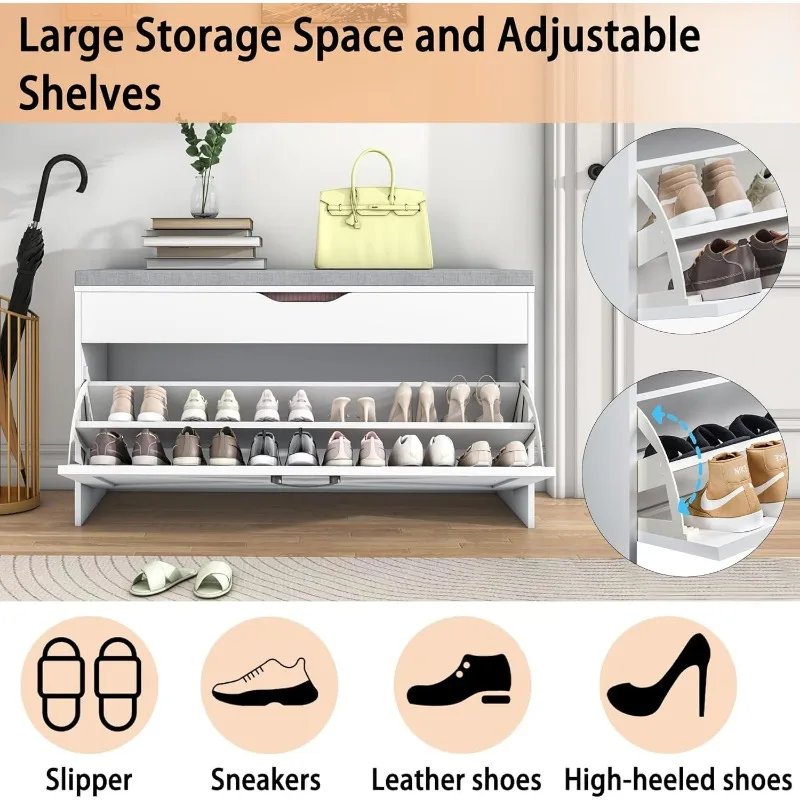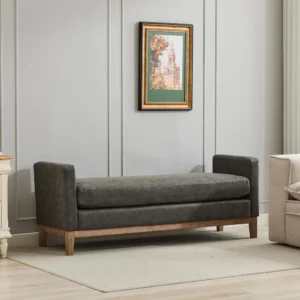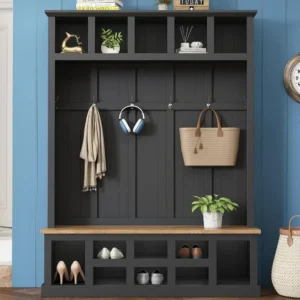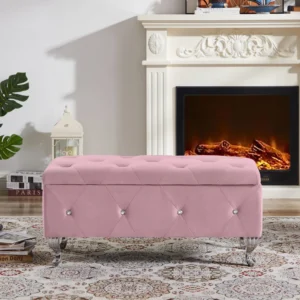Why Hallway Seating Transforms Your Home’s First Impression
The humble hallway often becomes one of the most overlooked spaces in our homes. These transitional areas frequently lack purpose beyond simply connecting rooms, becoming nothing more than a pass-through zone. Yet, these spaces hold tremendous potential to enhance both your home’s functionality and its aesthetic appeal.
Adding dedicated seating to your hallway instantly transforms it from a mere corridor into a purposeful space. This simple addition creates a practical spot for everyday moments—putting on shoes before heading out, waiting for family members to get ready, or setting down bags when you return home laden with groceries. Beyond these practical benefits, thoughtfully chosen hallway seating makes a powerful aesthetic statement, setting the tone for your entire home’s style.
The magic of hallway seating lies in its triple benefit: it serves daily practical needs, elevates your home’s visual appeal, and maximizes space that would otherwise go unused. Design psychology studies consistently show that well-designed entryways significantly impact how guests perceive your entire home, creating that crucial positive first impression.
Imagine the daily rhythm of household members rushing out in the morning—kids sitting to tie shoes, adults checking last-minute emails before departure—all made smoother with a dedicated seating area. Rather than awkwardly balancing on one foot or sitting on the stairs, revolutionize your entryway with smart seating options that blend seamlessly with your space.
Even in the narrowest of hallways, functional furniture for narrow hallways can transform these challenging spaces into practical, beautiful areas that welcome you home every day.
Bench Ideas: The Versatile Hallway Essential
When it comes to hallway seating, benches reign supreme as the most versatile and practical option. Their horizontal profile naturally complements hallway walls while providing a perfect balance of seating space and compact footprint.
Storage Bench Options
Storage benches offer the ultimate two-in-one solution for hallways:
- Flip-top storage benches – Perfect for hiding away seasonal items like hats, gloves, and scarves
- Shoe compartment benches – Open cubbies or drawers specifically designed for footwear organization
- Drawer benches – Sleeker appearance with pull-out storage for smaller items like dog leashes or kids’ accessories
Most hallway benches work best between 36-48 inches wide and 16-20 inches deep, providing ample seating without protruding too far into walkways. For materials, consider solid wood for timeless durability, metal frames for modern appeal, or upholstered tops for added comfort.
Space-Conscious Bench Styles
For narrower hallways, slim profile benches offer the perfect solution. These streamlined options often measure just 12-14 inches deep while still providing functional seating. Open-bottom benches create visual lightness in smaller spaces, allowing light to flow through while providing space underneath for baskets or shoes.
The farmhouse style bench with its rustic wood and simple lines brings warmth to traditional homes, while sleek metal-frame benches with minimalist cushions complement modern interiors perfectly. For those willing to invest in a truly customized solution, built-in benches can be crafted to fit unusual wall lengths or awkward corners.
Our entryway bench storage collection offers various storage configurations to keep hallway clutter at bay, while our narrow entryway bench options are specifically designed for tight spaces where every inch matters.
Space-Saving Ottomans: Compact Comfort with Hidden Storage
When a full bench might overwhelm your hallway, ottomans provide a compact yet highly functional alternative. These versatile pieces deliver comfortable seating with a significantly smaller footprint, making them perfect for narrow or shorter hallway spaces.
Storage ottomans are particularly valuable in hallway settings, offering hidden compartments that keep clutter out of sight:
- Flip-top storage ottomans easily hide smaller items like hats, gloves, or pet accessories
- Cube ottomans provide a clean, geometric look that works in contemporary spaces
- Round or oval ottomans soften angular hallways with their curved silhouette
Hallway-appropriate ottomans typically measure between 18-24 inches wide, creating a perfect “landing spot” near doorways without obstructing traffic flow. A single ottoman can comfortably store 4-6 pairs of shoes or several small accessories like scarves, gloves, and hats.
What makes ottomans especially practical is their mobility. When extra seating is needed elsewhere, these lightweight pieces can be temporarily relocated to living areas, then returned to their hallway home. Their smaller size also allows for playful style expressions through bold fabrics, interesting textures, or distinctive shapes that might overwhelm larger furniture pieces.
For placement, consider positioning ottomans near the most frequently used entrance, where they’ll provide immediate seating for shoe changes. In wider hallways, a pair of matching ottomans can create symmetry while doubling your seating and storage capacity.
Exploring options for stylish benches with hidden storage can revolutionize your entryway organization, while our selection of small shoe benches includes compact ottomans perfect for limited hallway spaces.

Wall-Mounted & Fold-Down Seating: Ultimate Space-Saving Solutions
For extremely narrow hallways where floor space is at an absolute premium, wall-mounted seating options offer the most intelligent solution. These innovative designs keep your pathways completely clear when not in use while providing functional seating exactly when needed.
Fold-down benches and chairs represent the ultimate space-saving approach. These clever pieces mount securely to your wall and fold flat against it when not needed, then pull down to provide sturdy seating on demand. Most fold-down hallway seating supports between 250-400 pounds (113-181 kg), making them surprisingly robust despite their slim profile.
Installation does require proper mounting into wall studs for safety, and you’ll need approximately 16-20 inches of clearance space when the seat is extended. However, this small investment in proper installation yields enormous space-saving benefits in tight corridors.
Floating benches offer another wall-mounted alternative that creates a modern, minimalist look. These pieces attach securely to the wall but don’t fold, appearing to “float” above the floor. The open space beneath enhances the visual spaciousness of narrow hallways while still providing functional seating.
For extremely challenging spaces like split-level entries or narrow pass-through areas, these wall-mounted options may be the only practical seating solution. They’re particularly valuable in apartment buildings with narrow common hallways or homes where adding even the slimmest freestanding bench would create a bottleneck.
Discover more clever space-saving hallway benches that can transform even the most challenging corridor into a functional, welcoming space.
Hall Trees & All-in-One Units: Complete Entryway Solutions
When you have sufficient space and want to maximize functionality, hall trees and all-in-one units deliver comprehensive hallway solutions that combine multiple functions in a single piece. These versatile furniture items typically integrate seating, coat hooks, and storage compartments in one cohesive unit.
Hall trees serve as command centers for busy households, providing dedicated space for all entryway essentials. Most hall trees feature a bench base for seating, multiple hooks or hanging rods for coats and bags, and additional storage through shelves, cubbies, or cabinets. This consolidation of functions eliminates the need for multiple separate pieces, creating a cleaner, more organized appearance.
Standard hall trees measure approximately 36-48 inches wide, 16-20 inches deep, and 60-72 inches tall. The seating portions typically support 250-300 pounds, while each hook can handle 5-10 pounds of coats and accessories. Materials range from solid wood constructions offering heirloom quality to metal-wood combinations providing contemporary industrial appeal.
These units excel in family homes where multiple people need organized entry and exit routines. The bench portion facilitates shoe changes, while the hook system ensures coats, bags, and backpacks have designated homes rather than ending up on floors or chairs. Upper shelves provide perfect storage for seasonal items like sunscreen in summer or gloves in winter.
Our hall trees and coat rack benches collection offers solutions ranging from rustic farmhouse to sleek modern designs, while our guide to transforming your entryway with bench and coat rack solutions provides inspiration for creating a cohesive entry system.
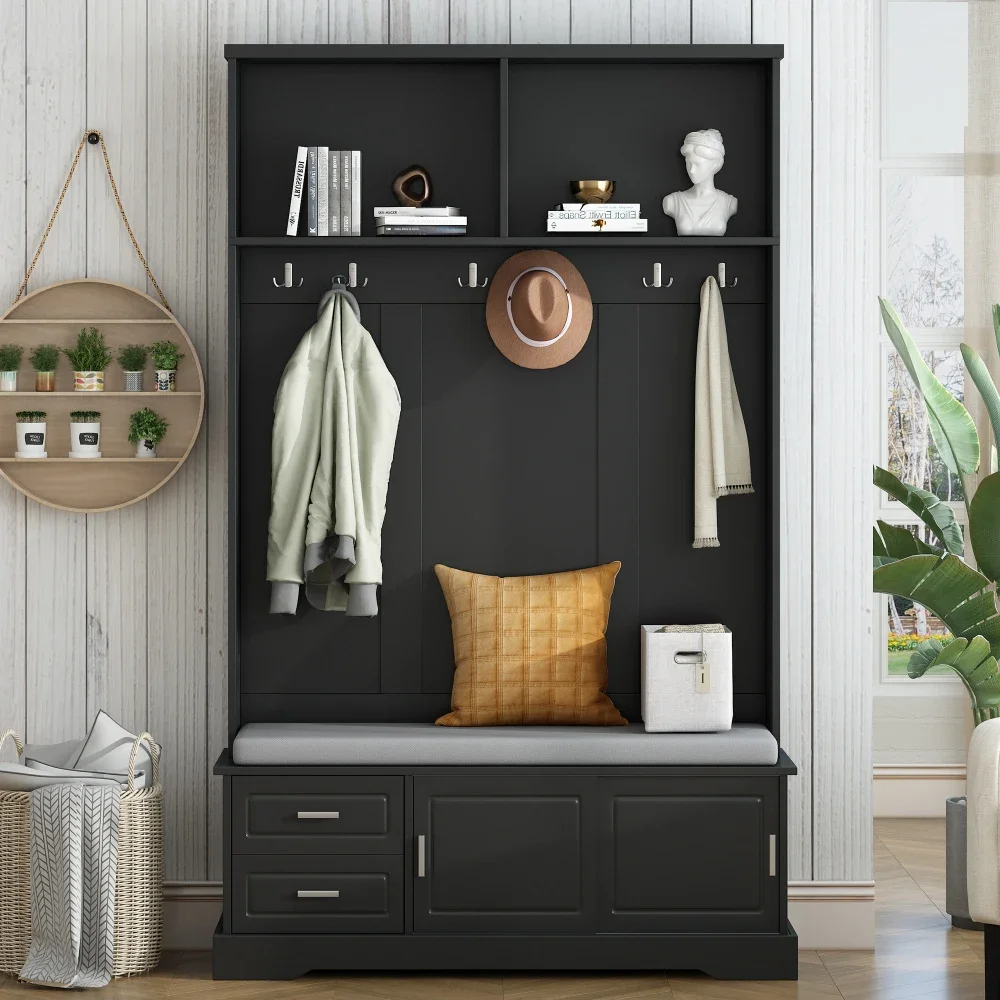
Creative Combinations: Console Tables with Integrated Seating
For hallways that demand elegance alongside functionality, the pairing of console tables with tucked-under seating creates a sophisticated solution that delivers the best of both worlds. This approach allows you to maintain the refined look of a console table while providing hidden seating that emerges only when needed.
Slim console tables (typically 30-48 inches wide and just 12-15 inches deep) provide valuable surface area for mail sorting, key storage, and decorative elements without protruding too far into the walkway. When paired with backless stools or benches designed to slide completely underneath, you create an arrangement that remains visually unobtrusive while having seating at the ready.
This combination works particularly well in hallways that double as transition spaces between more formal areas of the home. The console provides a styling opportunity to establish your home’s aesthetic through carefully chosen lamps, artwork, or decorative objects, while the seating remains discreet until guests need a spot to sit while removing shoes.
In L-shaped or wider hallways, a console with dual stools creates a balanced vignette against a focal wall. For straight, narrower hallways, a console with a single bench underneath provides functionality without visual clutter. The key to success with these combinations lies in ensuring the tucked-under seating completely disappears beneath the console when not in use.
Explore how to transform a small foyer with multi-use furniture to maximize both style and functionality in limited entry spaces.
Entryway Bench with Cushion, Mudroom Bench with Cushion, Shoe Bench for Entryway
$1,186.63 Select options This product has multiple variants. The options may be chosen on the product pageCoat Rack Shoe Bench, Corner Entryway Bench, Corner Hall Tree, Shoe Bench for Entryway
$313.58 Select options This product has multiple variants. The options may be chosen on the product pageCorner Entryway Bench, Entryway Bench with Cushion, Modern Entryway Bench, Shoe Bench for Entryway
$476.34 Select options This product has multiple variants. The options may be chosen on the product pageBench with Hooks and Storage, Entryway Hall Tree, Mudroom Bench with Cubbies, Mudroom Bench with Shoe Storage
$818.38 Select options This product has multiple variants. The options may be chosen on the product pageEntryway Coat Rack Bench, Entryway Hall Tree, Farmhouse Mudroom Bench, Mudroom Bench with Shoe Storage
$805.09 Select options This product has multiple variants. The options may be chosen on the product pageEntryway Bench with Cushion, Small Entryway Bench
$466.79 Select options This product has multiple variants. The options may be chosen on the product page
Statement Seating: Adding Personality with Chairs & Unique Pieces
For homeowners blessed with wider hallways, the opportunity to incorporate statement seating pieces offers exciting design potential. Unlike purely utilitarian options, these more distinctive pieces serve as focal points that express personal style while still providing functional seating.
Accent chairs work beautifully in hallway corners or wider sections where they won’t impede traffic flow. For hallway use, armless slipper chairs or slim-profile side chairs typically work best, requiring about 24-30 inches of space. Their vertical rather than horizontal orientation often fits better in transitional spaces while providing proper back support for longer sitting.
Unique statement stools—whether vintage piano stools, repurposed industrial pieces, or contemporary sculptural designs—add personality and create conversation pieces in entry areas. Their smaller footprint (typically 15-18 inches in diameter) makes them versatile for placement even in more modest-sized hallways.
When selecting statement pieces, consider how they’ll balance with other hallway elements. A bold, colorful chair might be paired with simpler wall treatments, while a more architectural piece in neutral tones could complement more dramatic wallpaper or artwork. The goal is creating a deliberate design moment rather than visual competition between elements.
Our entryway bench cushion collection features elegant upholstered pieces that add both comfort and style to hallway designs, creating that perfect statement moment when guests first enter your home.
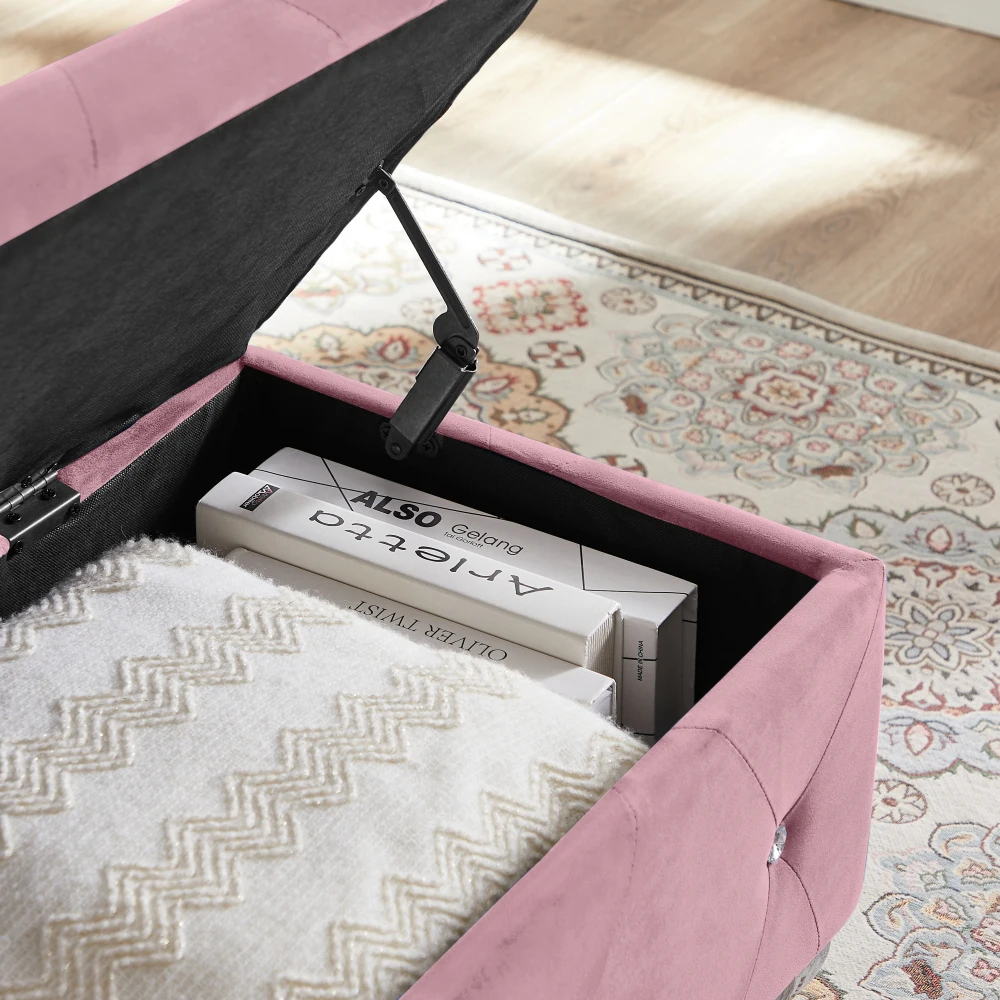
Built-in Seating Nooks & Window Seats: Architectural Hallway Features
Leveraging architectural features in your hallway can create seating opportunities that feel like they’ve always been part of your home’s design. Built-in seating makes use of otherwise awkward spaces while adding character and custom appeal to your entryway experience.
Window seats transform hallway windows into inviting nooks that invite pausing to enjoy the view. For comfort, window seats should be at least 16-18 inches deep, with 20-24 inches being ideal if space allows. Adding hinged tops to these built-ins creates valuable storage space for items not needed daily, such as seasonal decorations or guest bedding.
Under-stair spaces often go unused in split-level or two-story homes, yet they offer perfect recessed areas for built-in benches. These triangular spaces can be boxed in with simple woodwork to create seating that doesn’t protrude into the walkway. Adding drawers below maximizes the utility of these often-wasted square footage.
Wall recesses or alcoves present natural opportunities for bench installation, creating seating that doesn’t consume valuable floor space. Even a 12-inch deep recess can accommodate a slim bench that provides momentary seating for shoe changes.
What elevates these built-in options is their custom integration with your home’s architecture. Frame materials should complement existing trim work, while cushions and pillows add comfort while introducing color and texture. Lighting integrated above or beside these nooks creates welcoming pools of illumination that highlight these special features.
Discover smart entryway storage and seating solutions that help you make the most of every architectural opportunity your hallway presents.
Solving Common Hallway Challenges with Strategic Seating
Even the most challenging hallway configurations can be transformed with the right seating approach. By addressing specific spatial limitations head-on, you can find solutions that enhance rather than hinder your home’s functionality.
Conquering Narrow Hallways (Under 36 inches wide)
Extremely narrow hallways demand vertical thinking:
* Wall-mounted fold-down seating that disappears when not in use
* Floating benches that keep floor space open underneath
* Super-slim benches (10-12 inches deep) placed at wider end points
Enhancing these tight spaces visually is equally important. Mirrors positioned above seating reflect light and create the illusion of width, while light-colored seating blends with walls to avoid visual heaviness that makes spaces feel constricted.
Maximizing Small Entryways
Tiny entryways benefit from multi-tasking pieces:
* Corner benches that utilize often-wasted angular spaces
* Storage ottomans that serve triple-duty (seating, storage, and footprint minimization)
* Scaled-down hall trees (24-30 inches wide) that provide organization without overwhelming
For these compact areas, selecting furniture with visible legs creates visual breathing room by allowing sight lines to extend underneath the piece.
Controlling Hallway Clutter
Strategic storage integration transforms seating from clutter contributor to clutter solution:
* Bench cubbies with assigned baskets for each family member
* Lidded storage compartments that hide seasonal items
* Hook systems installed directly above seating for grab-and-go convenience
The key is creating organizational systems that accommodate your family’s actual habits rather than imposing solutions that look good but won’t be maintained.
Understanding the benefits of dual-purpose entryway seating helps you select pieces that solve multiple problems simultaneously—the smartest approach for challenging spaces.
Choosing Materials That Last: Durability in High-Traffic Areas
Hallway furniture endures some of your home’s heaviest use—from daily sitting to bag dropping to kids jumping—making material selection crucial for long-term satisfaction. Investing in quality materials for these hardworking spaces pays dividends in both appearance and functionality over time.
Frame Materials
Hardwoods (Oak, Maple, Walnut)
* Pros: Exceptional durability, aging beautifully, repairable
* Cons: Higher price point, may require occasional refinishing
* Best for: Investment pieces meant to last decades
Metal (Steel, Iron, Aluminum)
* Pros: Industrial strength, slim profiles possible, contemporary aesthetic
* Cons: Can feel cold without textile softening, potential for scratches
* Best for: Modern homes, pieces requiring minimal visual weight
Engineered Woods
* Pros: Budget-friendly, consistent appearance, good moisture resistance
* Cons: Difficult to repair if damaged, shorter lifespan than solid wood
* Best for: Growing families, medium-term solutions, painted pieces
Upholstery Considerations
Performance fabrics have revolutionized hallway seating, offering remarkable stain resistance while maintaining comfort. Brands specializing in indoor-outdoor fabrics provide textile options that withstand muddy shoes, wet umbrellas, and daily abuse while still looking refined.
Leather and quality faux leather options offer excellent durability with simple wipe-clean maintenance. Their smooth surface prevents dirt accumulation, making them ideal for homes with children or pets.
For maximum practicality, look for seating with removable, washable covers that allow for seasonal refreshing or emergency cleaning after inevitable spills. This feature extends furniture lifespan significantly in high-use areas.
For busy households dealing with heavy traffic and challenging conditions, our guide to mudroom seating for busy homes offers specific material recommendations that stand up to the toughest daily use.
Matching Your Hallway Seating to Your Home’s Style
Your hallway seating should feel like a natural extension of your home’s overall aesthetic. By identifying your core style and selecting pieces that reflect those design principles, you create a cohesive first impression that sets the tone for the entire home experience.
Modern & Minimalist Hallway Seating
Clean-lined benches with minimal ornamentation shine in these spaces. Look for materials like clear-finished wood, powder-coated metal, or molded plastic in neutral tones. Cushions, if any, should be simple rectangles in solid colors or subtle textures. Storage should be hidden rather than displayed.
Farmhouse & Rustic Options
Weathered woods, visible joinery, and handcrafted details define this welcoming style. Bench seats with spindle backs or cross supports feel appropriately casual, while fabrics tend toward natural fibers in plaid, ticking stripes, or simple solids. Open storage beneath creates an unfussy, accessible feeling.
Traditional & Elegant Choices
Upholstered benches with button tufting, nailhead trim, or turned legs elevate these more formal spaces. Look for richly stained woods, velvets, or leather upholstery with tailored detailing. Storage tends to be concealed behind doors with decorative hardware or panels.
Scandinavian Simplicity
Light-toned woods (especially birch and oak), clean functional forms, and textile accents in geometric patterns define this popular style. Benches typically feature slender profiles with just enough cushioning for comfort without bulk.
Contemporary Statements
Mixed materials—metal paired with wood, glass with concrete—create distinctly modern impact. Bold color accents, unexpected shapes, or oversized scale differentiate these pieces from more traditional options.
The key to success is identifying your home’s core style language and finding seating that speaks that same vocabulary. Our guide to optimized multi-functional entry seating explores how different styles can serve multiple functions while maintaining design coherence.
Practical Placement Tips: Creating Your Hallway Drop Zone
Strategic placement transforms ordinary hallway seating into a functional “drop zone” that supports your daily routines. Proper positioning and clearance planning ensures your seating enhances rather than hinders movement through these busy transitional spaces.
Measurement Guidelines for Success
- Maintain a minimum of 36 inches of clear walking path in hallways
- Position seating at least 24 inches away from doors that swing into the hallway
- For benches with storage underneath, allow 24-30 inches of clearance for accessing items
- Standard seating height should be 17-19 inches from the floor for comfortable sitting and standing
Integrating with Other Hallway Elements
Creating a cohesive drop zone means thinking beyond just the seating piece:
- Position mirrors 12-18 inches above seating to create functional getting-ready stations
- Install lighting (sconces or pendants) at eye level when seated to illuminate faces for last looks
- Add hooks at 60-65 inches height, positioned so hanging items won’t interfere with seated users
- Consider electrical outlet placement for phone charging stations in your entry setup
The most successful hallway arrangements create logical pairings: seating with mirror above for final appearance checks, bench with hooks above for grab-and-go ease, and seating with small table nearby for setting down items during transitions.
For more comprehensive guidance on creating functional entryway arrangements, explore our collection of practical entryway furniture ideas that maximize both style and usability in these high-traffic zones.
Beyond the Bench: Complementary Elements for Complete Hallway Design
Creating a truly functional hallway means thinking beyond seating alone. The most successful entryways pair seating with complementary elements that enhance both functionality and visual appeal, creating a cohesive welcome zone.
Wall-mounted hooks or racks positioned above or beside seating create intuitive hanging zones for coats, bags, and accessories. The ideal placement keeps items visible but organized, typically 12-15 inches above bench backs or 60-65 inches from the floor beside seating. Hooks with varied heights accommodate both adult and children’s reach, while decorative hook designs contribute to the overall aesthetic.
Mirrors serve dual practical purposes in hallway designs—they create the illusion of expanded space while providing that crucial last appearance check before heading out. Positioning a mirror above seating creates a natural getting-ready station. Consider shapes that complement your seating style: rectangular mirrors echo bench forms, while round mirrors soften angular seating.
Lighting transforms hallway functionality, especially during darker months. Wall sconces flanking mirrors provide even facial lighting, while pendant lights centered above seating create focused pools of illumination. For convenience, consider touch-activated lamps on nearby surfaces or motion-sensor options for hands-free operation.
Additional storage elements like slim console tables, floating shelves, or wall-mounted cabinets complement seating by providing dedicated space for keys, mail, and other small items that need immediate homes upon entering. When paired thoughtfully with seating, these elements create intuitive organizational systems that prevent everyday clutter from accumulating.
Our collection of entryway coat rack benches offers complete solutions that integrate multiple hallway functions into single, cohesive pieces perfect for busy households.
Making Your Final Choice: From Budget-Friendly to Investment Pieces
Selecting the perfect hallway seating ultimately comes down to understanding your specific needs, space constraints, and budget parameters. This framework will help you identify which features deserve your investment and where you might economize.
Assess Your Primary Use Case
- Quick transitions only – Simple seating without storage may suffice
- Organization hub needed – Prioritize storage capacity and compartment types
- Frequent guest use – Consider comfort and aesthetic impact more heavily
- Multi-person household – Size appropriately for simultaneous users
Space Realities
- Take precise measurements of your available space, including width, length, and any protruding elements
- Note the direction of door swings and ensure seating won’t block them
- Consider traffic patterns and maintain at least 36 inches of walking clearance
Storage Requirements
- Inventory what you need to store (shoes, bags, seasonal items)
- Determine if you prefer open storage (visually accessible) or closed storage (hidden away)
- Consider if storage needs will change seasonally and plan for maximum capacity times
Budget Considerations
Entry benches range widely in price, from approximately $100 for basic models to $1000+ for custom built-ins or high-end designer pieces. Generally:
- Simple wooden benches without storage: $100-300
- Quality storage benches: $300-600
- Hall trees and all-in-one units: $400-800
- Custom built-ins: $800+
Invest more in pieces made from solid hardwoods if longevity is your priority, while engineered woods offer good medium-term value. For upholstered pieces, performance fabrics justify their higher cost through significantly extended lifespan in high-traffic areas.
For growing families or those in transition, moderately-priced pieces with simple, classic lines offer the best value, while unique statement pieces may be worth the splurge for those with established styles and more permanent living situations.
Wondering if a hallway bench is right for your specific situation? Our guide on determining if you need an entryway bench walks you through the decision-making process for your particular home and lifestyle needs.
At Nested Goods, we understand that hallway seating isn’t just furniture—it’s the foundation of your home’s first impression and daily functionality. The right piece transforms not just your space, but your entire home experience.

